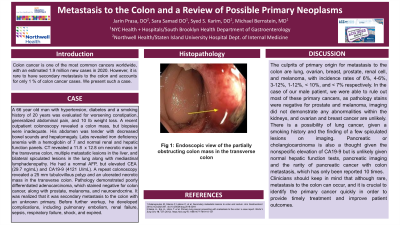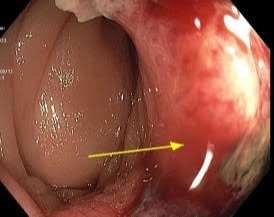Tuesday Poster Session
Category: Colon
P3065 - Metastasis to the Colon and a Review of Possible Primary Neoplasms
Tuesday, October 24, 2023
10:30 AM - 4:00 PM PT
Location: Exhibit Hall

Has Audio

Jarin Prasa, DO
Staten Island University Hospital
Brooklyn, NY
Presenting Author(s)
Jarin Prasa, DO1, Sara Samad, DO2, Syed S. Karim, DO3, Michael Bernstein, MD2
1Staten Island University Hospital, Brooklyn, NY; 2NYC Health + Hospitals, South Brooklyn Health, Brooklyn, NY; 3NYC Health + Hospitals South Brooklyn Health, Glen Oaks, NY
Introduction: Colon cancer is one of the most common cancers worldwide, with an estimated 1.9 million new cases in 2020. However, it is rare to have secondary metastasis to the colon and accounts for only 1 % of colon cancer cases. We present such a case.
Case Description/Methods: A 66 year old man with hypertension, diabetes and a smoking history of 20 years was evaluated for worsening constipation, generalized abdominal pain, and 10 Ib weight loss. A recent outpatient colonoscopy revealed a colon mass, but biopsies were inadequate. His abdomen was tender with decreased bowel sounds and hepatomegaly. Labs revealed iron deficiency anemia with a hemoglobin of 7 and normal renal and hepatic function panels. CT revealed a 11.8 x 12.8 cm necrotic mass in the transverse colon, multiple metastatic lesions in the liver, and bilateral spiculated lesions in the lung along with mediastinal lymphadenopathy. He had a normal AFP, but elevated CEA (29.7 ng/mL) and CA19-9 (4121 U/mL). A repeat colonoscopy revealed a 25 mm tubulovilous polyp and an ulcerated necrotic mass in the transverse colon. Pathology demonstrated poorly differentiated adenocarcinoma, which stained negative for colon cancer, along with prostate, melanoma, and neuroendocrine. It was realized that it was secondary metastasis to the colon with an unknown primary. Before further workup, he developed complications, including pulmonary embolism, renal failure, sepsis, respiratory failure, shock, and expired.
Discussion: The culprits of primary origin for metastasis to the colon are lung, ovarian, breast, prostate, renal cell, and melanoma, with incidence rates of 6%, 4-6%, 3-12%, 1-12%, < 10%, and < 7% respectively. In the case of our male patient, we were able to rule out most of these primary cancers, as pathology stains were negative for prostate and melanoma, imaging did not demonstrate any abnormalities within the kidneys, and ovarian and breast cancer are unlikely. There is a possibility of lung cancer, given a smoking history and the finding of a few spiculated lesions on imaging. Pancreatic or cholangiocarcinoma is also a thought given the nonspecific elevation of CA19-9 but is unlikely given normal hepatic function tests, pancreatic imaging and the rarity of pancreatic cancer with colon metastasis, which has only been reported 10 times.
Clinicians should keep in mind that although rare, metastasis to the colon can occur, and it is crucial to identify the primary cancer quickly in order to provide timely treatment and improve patient outcomes.

Disclosures:
Jarin Prasa, DO1, Sara Samad, DO2, Syed S. Karim, DO3, Michael Bernstein, MD2. P3065 - Metastasis to the Colon and a Review of Possible Primary Neoplasms, ACG 2023 Annual Scientific Meeting Abstracts. Vancouver, BC, Canada: American College of Gastroenterology.
1Staten Island University Hospital, Brooklyn, NY; 2NYC Health + Hospitals, South Brooklyn Health, Brooklyn, NY; 3NYC Health + Hospitals South Brooklyn Health, Glen Oaks, NY
Introduction: Colon cancer is one of the most common cancers worldwide, with an estimated 1.9 million new cases in 2020. However, it is rare to have secondary metastasis to the colon and accounts for only 1 % of colon cancer cases. We present such a case.
Case Description/Methods: A 66 year old man with hypertension, diabetes and a smoking history of 20 years was evaluated for worsening constipation, generalized abdominal pain, and 10 Ib weight loss. A recent outpatient colonoscopy revealed a colon mass, but biopsies were inadequate. His abdomen was tender with decreased bowel sounds and hepatomegaly. Labs revealed iron deficiency anemia with a hemoglobin of 7 and normal renal and hepatic function panels. CT revealed a 11.8 x 12.8 cm necrotic mass in the transverse colon, multiple metastatic lesions in the liver, and bilateral spiculated lesions in the lung along with mediastinal lymphadenopathy. He had a normal AFP, but elevated CEA (29.7 ng/mL) and CA19-9 (4121 U/mL). A repeat colonoscopy revealed a 25 mm tubulovilous polyp and an ulcerated necrotic mass in the transverse colon. Pathology demonstrated poorly differentiated adenocarcinoma, which stained negative for colon cancer, along with prostate, melanoma, and neuroendocrine. It was realized that it was secondary metastasis to the colon with an unknown primary. Before further workup, he developed complications, including pulmonary embolism, renal failure, sepsis, respiratory failure, shock, and expired.
Discussion: The culprits of primary origin for metastasis to the colon are lung, ovarian, breast, prostate, renal cell, and melanoma, with incidence rates of 6%, 4-6%, 3-12%, 1-12%, < 10%, and < 7% respectively. In the case of our male patient, we were able to rule out most of these primary cancers, as pathology stains were negative for prostate and melanoma, imaging did not demonstrate any abnormalities within the kidneys, and ovarian and breast cancer are unlikely. There is a possibility of lung cancer, given a smoking history and the finding of a few spiculated lesions on imaging. Pancreatic or cholangiocarcinoma is also a thought given the nonspecific elevation of CA19-9 but is unlikely given normal hepatic function tests, pancreatic imaging and the rarity of pancreatic cancer with colon metastasis, which has only been reported 10 times.
Clinicians should keep in mind that although rare, metastasis to the colon can occur, and it is crucial to identify the primary cancer quickly in order to provide timely treatment and improve patient outcomes.

Figure: Endoscopic view of the partially obstructing colon mass in the transverse colon
Disclosures:
Jarin Prasa indicated no relevant financial relationships.
Sara Samad indicated no relevant financial relationships.
Syed Karim indicated no relevant financial relationships.
Michael Bernstein indicated no relevant financial relationships.
Jarin Prasa, DO1, Sara Samad, DO2, Syed S. Karim, DO3, Michael Bernstein, MD2. P3065 - Metastasis to the Colon and a Review of Possible Primary Neoplasms, ACG 2023 Annual Scientific Meeting Abstracts. Vancouver, BC, Canada: American College of Gastroenterology.
